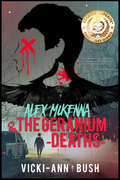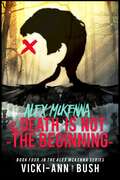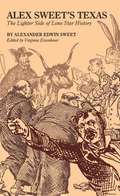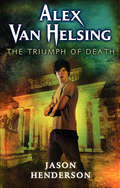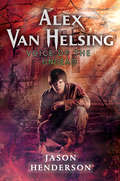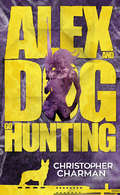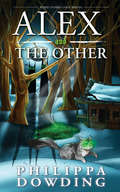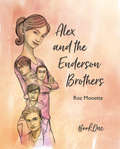- Table View
- List View
Alex McKenna & the Geranium Deaths (Alex McKenna #1)
by Vicki-Ann BushFor Alex McKenna, high school is just a distraction from the love of his life, Margaret, with whom he can't wait to spend more time once they get to college.In many respects, Alex is just an average seventeen-year-old boy...except for the fact he's a transgender medium born from a long line of Strega witches, possessing the ability to communicate with ghosts.With the help of Margaret and his talented Strega great-grandmother, Alex will learn how to strengthen his abilities. The dead need Alex to help them reconcile issues they left behind—and he finds that he needs them, too. As his abilities multiply, assisting the dead becomes an outlet to channel his new energy, giving him the strength to come to terms with who he is as a transgender male, and how far he will choose to go.
Alex McKenna and Death is Not the Beginning
by Vicki-Ann BushIn the fourth and final installment for the series, Alex faces his most difficult case yet: the school bully. For two years, Kyle had no qualms making Alex's life even more complicated than it already was. Choosing to single him out for his psychic abilities, the angry teen took every chance to undermine Alex's well-being. But When Kyle is unexpectedly murdered, his ghost seeks out Alex for the very power he'd been stigmatized for. Despite their fraught history, Alex must set aside old wounds to help a soul in need. Searching for the killer, Alex uncovers why Kyle had victimized him so intensely, and it's not what he ever could have expected. The truth, it turns out, will set them both free. The Alex McKenna Series in order: Alex McKenna and the Geranium Deaths Alex McKenna and the Academy of Souls Alex McKenna and a Winter's Night Alex McKenna and Death is Not the Beginning
Alex McKenna and a Winter's Night (Alex McKenna #3)
by Vicki-Ann BushThe third installment in the award-winning Alex McKenna Series, this LGBTQ teen paranormal adventure perfect for fans of Aidan Thomas’ CEMETERY BOYS and LOST IN THE NEVER WOODS. For a minute, everything in Alex McKenna’s life was perfect. He only had one year left of high school, his girlfriend Margaret was the love of his life, and he couldn’t ask for a more supportive family. His psychic powers were growing and he was learning more and more about his family’s abilities as Strega witches. Things were good. Until the night it all fell to pieces. As Margaret lies in the hospital after a serious car accident, her disembodied spirit searches for a way back to the living. Alex is desperate to save her and the victims of his next case: an ominous being haunting the hospital and stealing the souls of infants and the elderly, sending them straight to Hell. The Alex McKenna Series in order: 1. Alex McKenna and the Geranium Deaths 2. Alex McKenna and the Academy of Souls 3. Alex McKenna and a Winter’s Night
Alex Montana at ESH Manufacturing Co.
by Thomas J. Delong Michael KernishAlex Montana sat at his desk pondering the career decision before him. Alex was director of the North American division of ESH Manufacturing, a $4.6 billion, Cleveland-based company with operations on three continents. ESH's CEO had just offered Montana a promotion to global vice-president. Normally, Montana would have jumped at such an opportunity, but he worried about its impact on his already strained personal life. Since his last promotion, he had trouble balancing an increasingly demanding workload with his responsibilities to his wife and daughter at home. Montana felt pressure to accept the promotion. His boss expected him to accept; in fact, his boss had emphasized that he had no second choice. He had always dreamed of making it big in the business world. Success in this new role could put him in the running for COO and, eventually, CEO. But at what cost?
Alex Morgan (Amazing Athletes Ser.)
by Jon M FishmanWhen Alex Morgan was eight years old, she dreamed of becoming an Olympian. In 2012, that dream came true when she helped the United States Women's National Team (USWNT) win the soccer gold medal at the Olympic Games in London, England. In 2015, Alex and her USWNT teammates beat Japan in the championship match to win the World Cup. Alex is also an author, a model, and much more. Read all about Alex's life and her path to soccer stardom.
Alex Morgan: Soccer Champion (Stars of Sports)
by Matt ChandlerAlex Morgan first joined a soccer team when she was 14 years old, quickly impressing her peers and coaches with her skills. From there, she grew to become a world-class soccer player, reaching incredible heights including a FIFA Women's World Cup championship and an Olympic gold medal. Learn about Alex's rise in soccer in this electric biography in the Stars of Sports series.
Alex Rider: Secret Weapon: Seven Untold Adventures from the Life of a Teenaged Spy
by Anthony HorowitzAnthony Horowitz's short story collection expands the universe of teen spy Alex Rider with more thrilling action, espionage, and pulse-pounding heroics. <P><P> Inspired by Horowitz's millions of fans worldwide, Secret Weapon expands the world of Alex Rider with more thrilling action and pulse-pounding heroics. Follow Alex as he infiltrates a terrorist hideout in Afghanistan, fights to prevent an assassination attempt at a ski resort over Christmas, and much more! The #1 New York Times bestselling Alex Rider is back with more exciting, edge-of-your-seats adventures! <P><P> A great introduction to readers' favorite super-spy, Secret Weapon contains a combination of new and previously published material.
Alex Rider: Seven Untold Adventures From the Life of a Teenaged Spy (Alex Rider)
by Anthony HorowitzInternational bestselling author Anthony Horowitz's short story collection expands the universe of teen spy Alex Rider with more thrilling action, espionage, and pulse-pounding heroics. Inspired by Horowitz's millions of fans worldwide, Secret Weapon expands the world of Alex Rider with more thrilling action and pulse-pounding heroics. Follow Alex as he infiltrates a terrorist hideout in Afghanistan, fights to prevent an assassination attempt at a ski resort over Christmas, and much more! The #1 New York Times bestselling Alex Rider is back with more exciting, edge-of-your-seats adventures!Contains a combination of new and previously published material, together for the first time!Praise for Never Say Die:"Once again amid races, chases, hails of bullets, and increasingly spectacular explosions, the teenage James Bond pulls off one awesome feat of derring-do after another. [This] fresh caper . . . roars along to a (naturally) explosive climax." --Booklist
Alex Rodriguez Baseball Star
by Mary Ann HoffmanBrief biography of the baseball legend, Alex "A-Rod" Rodriguez.
Alex Rodriguez (Revised Edition)
by Jeffrey ZuehlkeAlex "A-Rod" Rodriguez of the New York Yankees has been breaking records since he joined the Major Leagues in 1994. In 2007, he made history again by becoming the youngest MLB player ever to hit 500 career home runs. This American League MVP and Gold Glove infielder is consistently at the top of the league in home runs and runs batted in. His amazing combination of offensive and defensive skills has made him one of baseball's highest-paid players. Follow A-Rod from his Miami childhood through his transformation into a superstar.
Alex Rodriguez: A+ Shortstop
by Mike ShalinMike Shalin's A+ Shortstop tells the life story of this popular player who has been voted by fans as an All-Star Game starter two years in a row. Rodgriguez has also been honored as Player of the Year from The Sporting News, an award voted on by Major League Baseball Players. By teaming up with Ken Griffey Jr., "A-Rod" has helped turn the Mariners into one of the most entertaining teams to watch in pro sports, and Shalin provides the details into his development from high school phenom to Major League star. Alex Rodriguez has a long career still ahead of him, but his accomplishments in the game so far have made him an athlete to llok up to for people around the country.
Alex Sweet's Texas: The Lighter Side of Lone Star History
by Sweet Alexander EdwinAlexander Edwin Sweet (1841-1901) is Texas's own "Sifter," whose humorous columns appeared in the Galveston Daily News in the late 1870s and early 1880s. In his wickedly funny, tongue-in-cheek sketches, readers learned of an astonishing variety of frontier phenomena, some familiar, others downright odd. For example, there was the typical nineteenth-century custom of New Year's Day receptions for bachelor guests only, with refreshments consisting largely of strong drink and equally strong fruitcake. Imbibing a bit more cheer at each stop, according to Sweet, the bachelors brought the last prospective sweethearts they visited New Year's greetings as incoherent as they were heartfelt. At times Sweet parodied the Yankee image of the typical Texan, whom he described as "half alligator, half human," eating raw buffalo and toting an arsenal of weaponry like a "perambulating gun-rack." But he also did as much as any writer to establish and enlarge upon the national image of Texas and Texans. Even the irascible red ant and the other "critters" in Sweet's column were Texas big and Texas-fabulous! In 1881 Sweet co-founded Texas Siftings, a humor magazine that moved from Austin to New York to become one of the most popular periodicals of its kind in the United States. From Texas Siftings, from Sweet's two published books (one called by John Jenkins in Basic Texas Books the "best volume of 19th century Texas humor"), and from many never-before-collected newspaper columns, editor Virginia Eisenhour has assembled an Alex Sweet sampler that presents the very best of the timeless humorist's work. The result—Alex Sweet's Texas—clearly demonstrates why the New York Journal pronounced Sweet "second to no living writer in freshness, originality, sparkling wit, and refined humor." A century later, that wit still sparkles and is guaranteed to delight Texans present as it once did Texans past.
Alex Van Helsing: The Triumph of Death
by Jason HendersonWithin months of discovering he's next in a long line of vampire hunters, Alex Van Helsing has already defeated two powerful vampire leaders. Not bad for a fourteen-year-old. But when a newly risen vampire queen threatens the fate of the world, Alex faces his deadliest challenge yet. Teaming up with a motorcycle-riding witch, Alex jets between Switzerland, the UK, and Spain in a frantic race to prevent the queen from unleashing a curse that will plunge the world into darkness. With the clock ticking, Alex barely has time to breathe, let alone see his friends, and he's beginning to wonder if being a vampire hunter is worth all its sacrifices. In this thrilling finale to the action-packed series described as "James Bond meets Dracula," everything-Alex's future and, ultimately, that of the world-hangs in the balance.
Alex Van Helsing: Vampire Rising
by Jason HendersonThe Van Helsing name reborn Fourteen-year-old Alex has no idea that he's descended from the world's most famous vampire hunter, but that changes fast when he arrives at Glenarvon Academy and confronts two vampires in his first three days. Turns out Glenarvon isn't the only school near Lake Geneva. Hidden deep underground lies an ancient university for vampires called the Scholomance. And the deadly vampire clan lord known as Icemaker? You might say he's a visiting professor. When two of Alex's friends are kidnapped by Icemaker, it's up to Alex to infiltrate the Scholomance and get them back--alive. Assisted by the Polidorium, a top-secret vampire-hunting organization with buried ties to the Van Helsings, Alex dodges zombies, bullets, and lots--and lots--of fangs on his way to thwarting Icemaker's plans and fulfilling his family destiny.
Alex Van Helsing: Voice of the Undead
by Jason HendersonNow that Alex is in the know about the deadly vampires that live-and hunt-around his boarding school, everything is different. Putting his talents to use, Alex is training with the Polidorium to become a vampire hunter, just like his Van Helsing ancestors. Sure, he's only fourteen, but c'mon: This runs in his blood. But Alex is wondering if he'll live long enough to succeed. His archnemesis Elle, a vampire whose youthful appearance and blond hair disguise a rage that's directed at him, is out to get him before a powerful leader called Ultravox arrives on the scene. Ultravox specializes in assassinations, but who is he targeting? As he dodges Elle's attacks, Alex is on a mission to uncover Ultravox's deadly plan before his friends and his school become collateral damage. There's no time to report back; innocent lives hang in the balance, and it's on Alex to act now-or else.
Alex Wise vs. the Cosmic Shift (Alex Wise #2)
by Terry J. Benton-WalkerNo one ever said saving the world would be easy. In the second installment of this thrilling fantasy series all about finding your inner hero, a 12-year-old boy leads the charge against the Horsemen of the Apocalypse.Alex Wise is no superhero. Or at least, he doesn't feel like one. Sure, he vanquished Death and saved his sister Mags—with the help of some new magic powers, his best friend Loren and demi-god Liam. But the apocalypse shows no signs of slowing down. Now, Alex and his friends will have to find new allies and face new dangers—from battling a giant snake in a literal ghost town and infiltrating the Horsemen&’s new home base on the Vegas Strip…on the back of a dragon. With everyone looking to him for answers, Alex isn't sure he's cut out for this world saving thing. And the closer he gets to Liam, the farther away he feels from Loren and from Mags, who hasn't been the same since she was possessed by Death. How can Alex lead a team if he doesn't even feel like he deserves to be a part of it? &“Never has the apocalypse been so fun!"—Mark Oshiro, author of THE INSIDERS and co-author with Rick Riordan of THE SUN AND THE STAR: A NICO DI ANGELO ADVENTURE.
Alex Wise vs. the End of the World (Alex Wise #1)
by Terry J. Benton-WalkerWelcome to the summer of the apocalypse. One 12-year-old boy leads the charge against the forces of evil as he tries to stop the Four Horsemen from taking over the world in the start to a wildly funny and addictive fantasy series about accepting yourself and finding your inner hero.Alex Wise feels like his world is ending. His best friend, Loren, is leaving town for the summer, his former friend and maybe sort of crush Sky hasn't spoken to him since he ditched Alex on first day of sixth grade, and now his mom is sending him and his annoying younger sister, Mags, on a cruise with the dad who abandoned them. And, as if things couldn't get worse, a creepy shadow monster may or may not be stalking him. But none of this could prepare Alex for the actual end of the world. Too bad that is exactly what's coming, after the definitely-real Shadow Man kidnaps Mags and she is possessed by the ancient spirit of Death—one of the Four Horsemen of the Apocalypse. Luckily (depending on who you ask), Alex is possessed as well by a powerful god who imbues Alex with their powers in an effort to stop the Horsemen…if he can figure out how to use them. So begins an epic battle between good and evil: Alex, Loren, a grumpy demi-god, and Alex's fourth grade teacher vs. Death, Pestilence, Famine, War, and the waves of chaos and destruction they bring to LA and soon the rest of the globe. Just your average summer vacation.Alex is more used to being left behind than leading the way, but now he's the only one who can save his sister—and the world. That is, if he can unlock his new powers and see himself as the hero he is.&“Never has the apocalypse been so fun!"—Mark Oshiro, author of THE INSIDERS and co-author with Rick Riordan of THE SUN AND THE STAR: A NICO DI ANGELO ADVENTURE.
Alex and Dog Go Hunting
by Christopher CharmanAlex doesn't have much to her name despite her knack for thieving and her passionate love of Veronica. When Alex is arrested and her relationship with Veronica shattered, she has only one way to clear her name and avoid life in prison.Years later, and now an asset of the US government, Alex has been transformed into a Special Ops assassin, and she has the engineered genes to prove it. Fighting her way through every blacklisted mission possible, and loving every minute of it, it isn't until she's delisted and on the streets that she meets David, a genetic whiz, who suspects that there's a flaw hidden in her new and improved DNA — a flaw that may prove fatal.Forging an uncanny relationship with Dog, a canine with incredible abilities, Alex learns that there are more dark rooms filled with government conspiracies than even she knew existed. As they dodge a desperate military, Alex realizes she'll have to face one of her worst battles yet: one of the heart.
Alex and Eliza: A Love Story (The Alex & Eliza Trilogy #1)
by Melissa de la Cruz<P> 1777. Albany, New York. <P>As battle cries of the American Revolution echo in the distance, servants flutter about preparing for one of New York society’s biggest events: the Schuylers’ grand ball. Descended from two of the oldest and most distinguished bloodlines in New York, the Schuylers are proud to be one of their fledgling country’s founding families, and even prouder still of their three daughters—Angelica, with her razor-sharp wit; Peggy, with her dazzling looks; and Eliza, whose beauty and charm rival those of both her sisters, though she’d rather be aiding the colonists’ cause than dressing up for some silly ball. <P>Still, Eliza can barely contain her excitement when she hears of the arrival of one Alexander Hamilton, a mysterious, rakish young colonel and General George Washington’s right-hand man. Though Alex has arrived as the bearer of bad news for the Schuylers, he can’t believe his luck—as an orphan, and a bastard one at that—to be in such esteemed company. And when Alex and Eliza meet that fateful night, so begins an epic love story that would forever change the course of American history. In the pages of Alex and Eliza, author Melissa de la Cruz brings to life the romance of young Alexander Hamilton and Elizabeth Schuyler. <P><b>A New York Times Bestseller</b>
Alex and Me: How a Scientist and a Parrot Discovered a Hidden World of Animal Intelligence— and Formed a Deep Bond in the Process
by Roger Lewin Irene PepperbergOn September 6, 2007, an African Grey parrot named Alex died prematurely at age thirty-one. His last words to his owner, Irene Pepperberg, were 'You be good. I love you'. What would normally be a quiet, very private event was, in Alex's case, headline news. Over the thirty years they had worked together, Alex and Irene had become famous - two pioneers who opened an unprecedented window into the hidden yet vast world of animal minds. Alex's brain was the size of a shelled walnut, and when Irene and Alex first met, birds were not believed to possess any potential for language, consciousness, or anything remotely comparable to human intelligence. Yet, over the years, Alex proved many things. He could add. He could sound out words. He understood concepts like bigger, smaller, more, fewer, and none. He was capable of thought and intention. Together, Alex and Irene uncovered a startling reality: We live in a world populated by thinking, conscious creatures. The fame that resulted was extraordinary. Yet there was a side to their relationship that never made the papers. They were emotionally connected to one another. They shared a deep bond far beyond science. Alex missed Irene when she was away. He was jealous when she paid attention to other parrots, or even people. He liked to show her who was boss. He loved to dance. He sometimes became bored by the repetition of his tests, and played jokes on her. Sometimes they sniped at each other. Yet nearly every day, they each said, 'I love you'. Alex and Irene stayed together through thick and thin - despite sneers from experts, extraordinary financial sacrifices, and a nomadic existence from one university to another. The story of their thirty-year adventure is equally a landmark of scientific achievement and of an unforgettable human-animal bond.
Alex and The Other: Weird Stories Gone Wrong (Weird Stories Gone Wrong #4)
by Philippa DowdingBeware The Other … Alex is the loneliest boy at school. Not only are his parents away (again), but his beloved cat is missing. Plus, one morning his reflection in the haunted bathroom mirror at school starts talking to him. Then two mysterious strangers in overcoats and sunglasses appear, whispering the same message, over and over: Beware The Other.… But, worse than all that, is the girl with the braid. She looks just like Alex. She’s better than him at everything, and they even share the same name. Soon, she’s the only Alex anyone can see, at school, at work, even at home. In no time, it’s almost as though the real Alex never existed at all. Can the real Alex outsmart his evil twin and get his life back before she replaces him for good? And, more importantly, who is the real Alex, anyway?
Alex and the Alpacas Ride Again
by Kathryn LefroyAfter her adventures in Tasmania, Alex is back home in Melbourne and ready for the next one. But Grandpa Jacob wants to keep Alex protected, and he wants her to go back to being a regular kid and forget that she is the saviour of the world. Why can't he understand that she's not normal, she's special? When things start to happen around the olive sapling housing Kiala's spirit, Alex sees her chance to prove how important she is, but at what cost? When Ivette, an unexpected arrival from America, tries to assert herself into the mission, Alex is left questioning herself and her abilities, as she attempts to put her trust in others.
Alex and the Alpacas Save the World
by Kathryn LefroyAlex is expecting a pretty boring summer. But when Mum takes her to visither mysterious grandfather on his farm in Tasmania, weird things start tohappen ... Weirdest of all? Her grandfather's pet alpacas ... who can talk!When things go from strange to scary, Alex must use all her brains, brawnand bravery in order to survive the sinister forces threatening life as sheknows it.
Alex and the Enderson Brothers: Book One
by Roz MonetteThe Enderson brothers dominate the social scene and bring excitement to the uneventful town of Plainville. Scott, Chris, Otto, and Ryan are well-known and well-liked—most of the time. Their loyalty to each other is indestructible until one brother drifts into the wrong crowd. Then there's Alex, the family's youngest child and only daughter, who struggles to rise above her family's reputation. While her brothers enjoy their teenage freedom, Alex deals with the frustrations of youth and is constantly reminded that someday she will become a mature woman, someday boys will like her, and someday she'll look back at her youth and laugh. After a revelation by the outcast brother, the family is divided. Their dad has to remind all the kids who's really in charge despite the devastating consequences. Will the Enderson family ever be the close-knit group they once were?
